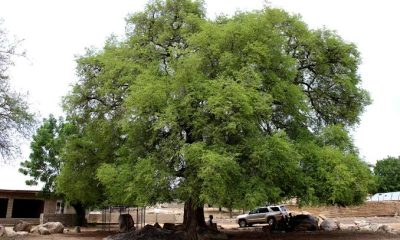News
China-Africa Infrastructure Cooperation:Building the Groundwork for a Better Future

China-Africa Infrastructure Cooperation:
Building the Groundwork for a Better Future
By: Yi Xin
When speaking of China-Africa cooperation, the word “kaleidoscopic” comes to mind. Recent years have seen fruitful outcomes of the bilateral cooperation in multiple fields. Among them, infrastructure is hardly one to miss.
From the plateau in the east to the coast in the west, from the landlocked countries in the sub-Saharan region to the small island states in the Western Indian Ocean, roads, railways, bridges, ports, schools, hospitals and power stations built with Chinese assistance are paving the groundwork for a better future for a land of promise and potential.
Transport projects drive a more connected future.
“To get rich, build roads first.” This is not just a popular Chinese proverb, but an important takeaway from China’s own development. Drawing on this experience, China has spent decades working with Africa to build the transport backbone necessary for driving economic growth.
It would be remiss not to mention the Addis Ababa-Djibouti Railway (AADR), a transport artery connecting Ethiopia and Djibouti and the first electrified transnational railway in East Africa. It is a flagship Belt and Road cooperation project, and one of the two main lines of transport in the Outlook on Peace and Development in the Horn of Africa which China put forward in 2022 to support regional countries in addressing security, development and governance challenges.
The railway greatly improved the access of countries along the route to the outside world. It has cut transport time for freight goods from more than three days to less than 20 hours, and reduced the cost by at least one-third. To date, the railway has transported 680,000 passengers and 9.5 million tons of cargo, with an average annual growth rate of 39 percent in revenue. As countries in the region grapple with soaring oil prices, the electrified railway has played an increasingly important role in delivering essential materials such as edible oil and fertilizers to meet the needs of socioeconomic development.
In May this year, the Chinese contractors handed over the railway’s management and operation to the African side after six years of smooth operation. Ethiopian Minister of Finance Ahmed Shide said, “The Addis Ababa-Djibouti railway line is an example of the ever-flourishing Sino-African relations. The Sino-African partnership has passed the test of time, demonstrated its resilience, and marks a brighter and strong future.”
In recent years, more and more infrastructure projects in Africa undertaken by China have yielded tangible benefits, often exceeding the traditional transport domain. Since the establishment of the Forum on China-Africa Cooperation (FOCAC) in 2000, according to the “China and Africa in the New Era: A Partnership of Equals” white paper, Chinese companies have helped African countries build or upgrade more than 10,000 km of railways, nearly 100,000 km of highways, nearly 1,000 bridges, nearly 100 ports, 66,000 km of power transmission and distribution, an installed power-generating capacity of 120 million kW, a communications backbone network of 150,000 km, and a network service covering nearly 700 million user terminals.
Blue economy cooperation cultivates talent.
The ocean connects countries; it also bears infinite hope. In recent years, under the Vision for Maritime Cooperation under the Belt and Road Initiative and The Belt and Road Blue Cooperation Initiative, China has taken concrete steps to forge a blue partnership with Africa.
In China-Africa Cooperation Vision 2035 released at the eighth FOCAC Ministerial Conference in 2021, cooperation on the blue economy is listed as a “new growth area” that can “add value to and sustainably utilize marine resources.” The infrastructure projects in this field have created many local jobs and helped train much-needed engineers, technicians and other skilled professionals for Africa.
The Lamu Port Project in Kenya is an exemplar. It has an important place in Kenya Vision 2030, the country’s long-term development blueprint. Built by a Chinese company, the port is part of Kenya’s bid to become a major trading hub in East Africa.
Over three-quarters of the project’s hirees were African. The Chinese companies send experienced and skilled Chinese workers to provide on-the-job training for local recruits. This was met with much enthusiasm among young Africans. More than 2,500 job opportunities with such tailored training produced a large number of skilled workers. After the project was completed, they were able to find new jobs and lead better lives with the skills they mastered.
Green economy cooperation supercharges energy transition.
China has been an important partner in Africa’s green transition. To date, China has undertaken more than 100 clean energy projects under the FOCAC framework, supporting African countries in making better use of clean energy such as solar, hydro, wind and geothermal power.
The De Aar Wind Farm has changed the energy landscape of South Africa. As the first wind power project financed, constructed and operated by a Chinese company in Africa, it supplies 760 million kilowatt-hours of clean electricity annually, meeting the electricity needs of 300,000 households. This has contributed to closing the gap caused by unstable clean energy and addressing the electricity shortage in South Africa.
China’s continuous efforts to help develop infrastructure in Africa over the decades find roots in Confucian philosophy. To quote The Analects, “ A man of virtue, while establishing himself and pursuing success, also works to establish others and enable them to succeed as well.” In other words, in pursuing its own development, China sincerely hopes to see African countries, which are also important members of the Global South, become prosperous and strong.
(Yi Xin is a Beijing-based international affairs commentator.
China-Africa Infrastructure Cooperation:
Building the Groundwork for a Better Future
News
U.S. president orders deadly strikes against ISIS militants in northwest Nigeria

U.S. president orders deadly strikes against ISIS militants in northwest Nigeria
By: Zagazola Makama
President Donald J. Trump announced that the United States had launched a powerful and deadly military strike against Islamic State (ISIS) terrorist targets in Nigeria, in response to what he described as ongoing attacks on primarily innocent Christians in the region.
In a post on his social media platform, Mr. Trump said the operation was conducted “at my direction as Commander in Chief” and targeted ISIS militants whom he accused of “viciously killing, primarily, innocent Christians, at levels not seen for many years, and even centuries.”
The president said he had previously warned the extremist group to halt attacks on Christians or face consequences, adding: “tonight, there was.”
Mr. Trump described the strikes as “numerous perfect strikes, as only the United States is capable of doing,” and reiterated that under his leadership the U.S. would not allow “Radical Islamic Terrorism to prosper.” He extended Christmas greetings to U.S. military forces and said there would be “many more” such strikes if the killing of Christians continued.
The announcement marks a significant escalation of U.S. military involvement in Nigeria’s complex security landscape. Western and Nigerian officials have long warned that militant groups such as ISIS’s West Africa Province (ISWAP) and Boko Haram pose a persistent threat in northern Nigeria, where attacks on civilians including Christians and Muslims alike have killed thousands over the past decade.
Reactions to the U.S. action are still emerging. The strikes come amid ongoing debates over Nigeria’s sovereignty and the best approach to combat extremist violence in West Africa. Previous statements by the Nigerian government welcomed U.S. assistance in fighting terrorism provided it respects the country’s territorial integrity.
The full military impact of the operation including casualties among militants or its implications for Nigeria’s internal security strategy has not yet been independently verified.
End
News
VP Shettima: Borno Attack Will Not Break Nigeria’s Resolve

VP Shettima: Borno Attack Will Not Break Nigeria’s Resolve
By: Our Reporter
Vice President Kashim Shettima has condemned in strong terms the bomb explosion that claimed about five lives and left several others injured at a Mosque in Gamboru Market, Maiduguri, Borno State, describing the attack as a despicable assault on innocent citizens and the peace of the nation.
The Vice President said President Bola Ahmed Tinubu has ordered an immediate intensification of security operations in Borno State following the incident.
In a statement on Thursday, the Vice President condemned the attack, assuring that the Federal Government is deploying additional tactical teams to the area to track down and apprehend those responsible for the terror attack.
“The Federal Government will not tolerate any attempt to undermine the peace and security of our nation. Our security agencies are working round the clock to ensure that the perpetrators of this heinous crime are brought to justice immediately,” he said.
Senator Shettima expressed confidence that the security architecture currently in place would not only apprehend the perpetrators but also unravel the full circumstances surrounding the incident.
“We sympathize with the Government of Borno State, residents, and families who have lost their loved ones in this attack. The Federal Government is confident that those responsible for this despicable act of terrorism will face the full weight of the law,” VP Shettima said.
He assured Nigerians that the Tinubu administration’s commitment to national security, anchored in constitutional duty, remains unwavering.
“Since President Bola Ahmed Tinubu assumed office in 2023, this administration has consistently reaffirmed its unyielding commitment to safeguarding the security, unity, and stability of our nation.
“This commitment remains steadfast under God and the Constitution of the Federal Republic of Nigeria. We will continue to provide our security agencies with all necessary resources and support to decisively defeat terrorism in all its forms,” he affirmed.
The Vice President added that the Federal Government is working closely with state authorities and local security agencies to ensure protection of vulnerable communities and critical infrastructure across the North East and other regions.
VP Shettima: Borno Attack Will Not Break Nigeria’s Resolve
News
Zulum-“Protect Our Sacred Bond,” Celebrates Peaceful Year in Christmas Message

Zulum-“Protect Our Sacred Bond,” Celebrates Peaceful Year in Christmas Message
By: Our Reporter
With profound gratitude to God for sparing our lives one full year to another Christmas celebration, Borno State Governor, Professor Babagana Umara Zulum felicitate with the Christian community across the state on the occasion of Christmas.
The Governor is currently engaged in a four-day security and resilience building tour across Northern Borno. The tour includes visits to military formations to boost their morale, and to communities affected by the insurgency, where he is working to build their confidence and provide tangible democratic benefits.
In a message by his Spokesperson Dauda Iliya, Governor Zulum expressed gratitude to God Almighty for the return of relative peace in the state.
“For us in Borno State, the period between the 2024 to the 2025 Christmas celebrations has been one full year of celebrating enviable all-encompassing reconstruction and recovery,” Zulum stated.
“The progress is not only in terms of physical infrastructure, but also in terms of the peace and forbearance, mutual goodwill and harmonious coexistence among the Muslim and Christian communities, which our beleaguered state very critically desires to launch itself back to prosperity and glorious past,” he added.
“I feel obliged to express my most heartfelt gratitude to God for enabling me to preside over the state one full year, witnessing a gladdening restoration and maintenance of these required peace, mutual goodwill and harmony between the the Muslim and Christian communities which bonded us tightly together as a solid people, but which the over a decade Boko Haram insurgency threatened to completely destroy.
“A noteworthy part of the Muslim-Christian harmonious coexistence and goodwill reconstruction and maintenance was my recent high-level consultation meeting with the leadership of Jama’atu Nasril Islam (JNI) and Christian Association of Nigeria (CAN), focused on strengthening collaborative efforts between the state government and religious bodies to combat the lingering threat of insecurity and foster lasting peace in Borno State.
“At that meeting, I underscored the critical role of religious leaders in promoting tolerance, unity and peace across the state because Borno, like many states, has unique and beautiful family composition dynamics.
“It is common to find under one roof, brothers and sisters, uncles and aunts, who profess different faiths. We share meals, we celebrate festivities and milestones, we grieve losses together, as one family, bound by blood and love that transcends religious labels. This is our reality.
“I stressed that our enviable strength emanates from this reality. I will still, therefore, stress that we must protect this sacred bond within our homes and allow it to define our individual, as well as intra- and cross-community engagements.
“In sustenance of my tradition of just, fair and equitable treatment of both communities in festive seasons, I have, also, this year, I announced support to the Christian community and non indigenes, which includes free transportation to non-indigenes to different parts of the country, humanitarian support to over 6,000 vulnerable Christians, cash gifts to widows and orphans, sponsorship of Christian pilgrimage and other interventions.
I am always disposed to rendering such support, and even more, whenever the need arises.
Governor Babagana Zulum urge every citizen of the state, irrespective of faith, to come together in the collective search for lasting security, peaceful and harmonious coexistence as the most-critical foundation for true reconstruction, recovery and prosperity.
Zulum-“Protect Our Sacred Bond,” Celebrates Peaceful Year in Christmas Message
-

 News2 years ago
News2 years agoRoger Federer’s Shock as DNA Results Reveal Myla and Charlene Are Not His Biological Children
-

 Opinions4 years ago
Opinions4 years agoTHE PLIGHT OF FARIDA
-

 News8 months ago
News8 months agoFAILED COUP IN BURKINA FASO: HOW TRAORÉ NARROWLY ESCAPED ASSASSINATION PLOT AMID FOREIGN INTERFERENCE CLAIMS
-

 Opinions4 years ago
Opinions4 years agoPOLICE CHARGE ROOMS, A MINTING PRESS
-

 News2 years ago
News2 years agoEYN: Rev. Billi, Distortion of History, and The Living Tamarind Tree
-

 ACADEMICS2 years ago
ACADEMICS2 years agoA History of Biu” (2015) and The Lingering Bura-Pabir Question (1)
-

 Columns2 years ago
Columns2 years agoArmy University Biu: There is certain interest, but certainly not from Borno.
-

 Opinions2 years ago
Opinions2 years agoTinubu,Shettima: The epidemic of economic, insecurity in Nigeria





